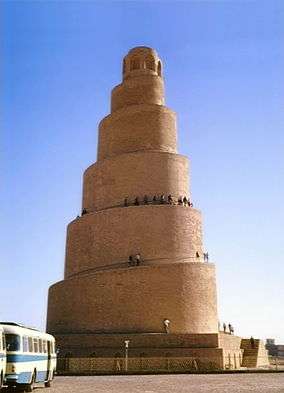Great Mosque of Samarra
| Great Mosque of Samarra | |
|---|---|
|
Minaret at the Great Mosque of Samarra | |
| Location | Samarra, Iraq |
| Coordinates | 34°12′21″N 43°52′47″E / 34.20583°N 43.87972°ECoordinates: 34°12′21″N 43°52′47″E / 34.20583°N 43.87972°E |
| Established | 848 |
The Great Mosque of Samarra[1] is a ninth-century mosque located in Samarra, Iraq. The mosque was commissioned in 848 and completed in 851 by the Abbasid caliph Al-Mutawakkil who reigned (in Samarra) from 847 until 861.
The Great Mosque of Samarra was, for a time, the largest mosque in the world; its minaret, the Malwiya Tower, is a spiralling cone 52 meters high and 33 meters wide with a spiral ramp.[2] The reign of al-Mutawakkil had a great effect on the appearance of the city, for he seems to have been a lover of architecture, and the one responsible for building the great Mosque of Samarra.[3] In a list of his building projects which appears in several different versions, the new Congregational Mosque and up to twenty palaces are mentioned, totalling between 258 and 294 million dirhams. The new Congregational Mosque, with its spiral minaret, built between 849 (235 AH) and 851 (235 AH), formed part of an extension of the city to the east, extending into the old hunting park.[4]
The mosque had 17 aisles, and its walls were panelled with mosaics of dark blue glass. It was part of an extension of Samarra eastwards.
The art and architecture of the mosque were influential; stucco carvings within the mosque in floral and geometric designs represent early Islamic decoration. Additionally, the mosque of Ibn Tulun in Cairo, Egypt was based on the Samarra mosque in many regards.[5]
The mosque itself was destroyed in 1278 (656 AH) after the Hulagu Khan invasion of Iraq. Only the outer wall and its minaret remain.[6]
"Great mosque, Samarra, was built during the caliphate of al-Mutawakkil. It is the largest mosque in the world. Built entirely of brick within a wall flanked with towers, it has a 55 m high minaret with a spiral ramp that recalls the ziggurats of Mesopotamia".— Henri Stierlin, Comprendre l'Architecture universelle 2. p347.[7]
Malwiya
The Malwiya Minaret (Arabic: ملوية malwiyah) is part of the Great Mosque of Samarra. The minaret was originally connected to the mosque by a bridge.
The minaret or tower was constructed in 848 – 852 of sandstone, and is unique among other minarets because of its ascending spiral conical design. 52 metres high and 33 metres wide at the base, the spiral contains stairs reaching to the top.[8] The word "malwiya" translates as "twisted" or "snail shell."[9][10]
The Malwiya was used for the "call to prayer"; its height made it practical for such use. It is visible from a considerable distance in the area around Samarra and therefore may have been designed as a strong visual statement of the presence of Islam in the Tigris Valley.[8]
The minaret's spiral shape inspired Pritzker Architecture Prize winner Philip Johnson's design for the 1976 Chapel of Thanksgiving at Thanks-Giving Square in Dallas, Texas.[11]
In 2005 the top of the Malwiya minaret was damaged by a bomb. Iraqi police said insurgents blew up the top section of the 52m (162ft) tower, which had previously been used by US soldiers as a lookout position, although US troops had pulled out of the site a month before.[12][13]
References
- ↑ in Arabic: جامع سامراء الكبير or المسجد الجامع في سامراء or مسجد سامراء الكبير
- ↑ See Historic Mosques site.
- ↑ Dennis, Sharp (1991). The Illustrated Encyclopedia of Architects and Architecture. New York: Whitney Library of Design. p. 204.
- ↑ D. Hoag., John. Islamic Architecture. Electra/Rizzoli.
- ↑ Behrens-Abouseif, Doris. "Islamic architecture in Cairo: an introduction." American University in Cairo Press: 2005. 51-57
- ↑ "مسجد سامرا ؛ برخوردار از مناره ای 53 متری و حلزونی شکل" (in Persian). Mehr News Agency. Retrieved 27 March 2012.
- ↑ Henri, Stierlin (1977). Comprendre l'Architecture Universelle 2. Fribourg, Switzerland: Office du Livre. p. 347.
- 1 2 Kleiner, Fred S. and Christin J. Mamiya. Gardner's Art Through the Ages: 12th edition. Thomson Wadsworth, 2005
- ↑ Kuban, Doğan (1974). "The Development of Early Mosque Architecture". The Mosque and Its Early Development. Leiden, Netherlands: Brill Publishers. p. 16.
- ↑ Kleiner, Fred (2011). "The Islamic World". Gardner’s Art through the Ages: Backpack Edition, Book 3. Boston: Cengage Learning. p. 289.
- ↑ http://www.thanksgiving.org/thanks-giving-square/visit/tour/
- ↑ "Middle East | Ancient minaret damaged in Iraq". BBC News. 2005-04-01. Retrieved 2015-09-03.
- ↑ http://www.cemml.colostate.edu/cultural/09476/images/iraq08-02-sniper2.jpg
External links
- The Great Mosque, Samarra, Iraq
- Photo of The Great Mosque
- Photo and information
- Photos, floor plans, and information
- Ernst Herzfeld Papers, Series 7: Records of Samarra Expeditions, Great Mosque of al-Mutawakkil Collections Search Center, S.I.R.I.S., Smithsonian Institution, Washington, DC
- Ernst Herzfeld Papers, Series 7: Records of Samarra Expeditions, 1906-1945 Smithsonian Institution, Freer Gallery of Art and Arthur M. Sackler Gallery Archives, Washington, DC

.jpg)
